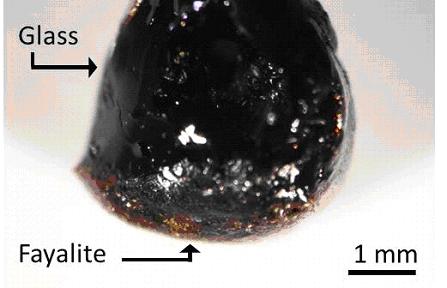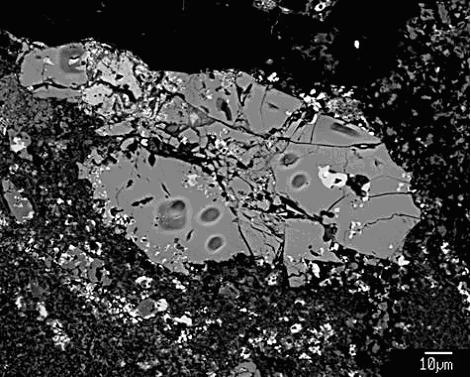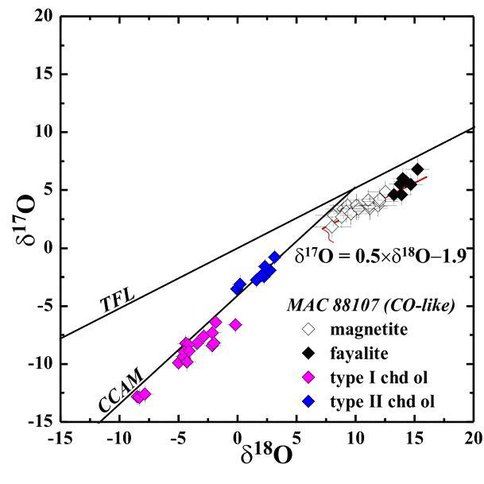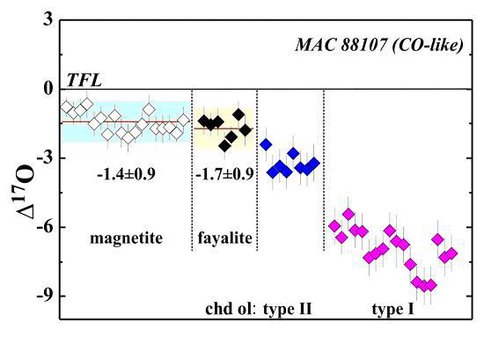2012 Annual Science Report
 University of Hawaii, Manoa
Reporting | SEP 2011 – AUG 2012
University of Hawaii, Manoa
Reporting | SEP 2011 – AUG 2012
Determining the Age and Nature of Asteroid Aqueous Alteration
Project Summary
Scientists who model thermophysical, chemical and dynamical properties of small bodies base their parameters on the understanding that minerals like fayalite (Fe2SiO4, with trace Mn and Cr) formed by aqueous (water) alteration within the asteroid. Our studies of rock textures and isotopic data are consistent with fayalite forming during aqueous alteration. We are using oxygen isotopes to define the oxygen-isotope composition of the asteroidal water, and Mn-Cr isotopes to determine when the mineral formed.
Our results show that fayalite-bearing assemblages formed in situ, during fluid-rock interaction at low water-to-rock ratios and temperatures below 300°C. The 53Mn-53Cr chronometry investigation requires standards of appropriate composition, so we have created synthetic fayalite under known temperature and oxygen fugacity controlled by mixtures of H2 and CO2. Future chronometry investigations will use these well-characterized standards when analyzing meteoritic fayalites from different parent bodies. The combination of O and Mn-Cr isotopic data will be used to constrain the nature and timing of key water-related processes within the early Solar System.
Project Progress
Oxygen isotope systematic: Olivine in Type I and Type II chondrules associated with fayalite-bearing assemblages within CO-like MAC 88107 chondrite has Δ17O values of −6.9±1.8‰ and −3.2±0.8‰ respectively. In contrast, fayalite and co-existing magnetite within MAC 88107 have Δ17O values of −1.8±1.0‰ and are therefore in isotopic disequilibrium with the chondrules. These observations, together with mineralogical observations and thermodynamic analysis, indicate that fayalite-bearing assemblages formed in situ, during fluid-rock interaction at low water-to-rock ratio and temperatures below 300°C.
The observed differences in Δ17O values of fayalite-bearing assemblages in unequilibrated ordinary chondrites, UOCs (4.3±1.1‰), CVs (~ −1‰), and MAC 88107 (−1.8±1.0‰), suggest that H2O ices that accreted into ordinary and carbonaceous chondrite parent asteroids had different O-isotope compositions. These compositions are inconsistent with significant flux of isotopically heavy H2O from the outer Solar System as hypothesized in the CO self-shielding models.
Mn-Cr chronometry: The relative sensitivity factor (RSF) used in Mn-Cr isotope chronometry varies, depending on the fayalite content in olivine. Indeed, our results show that the initial ratio differs by a factor of three when a single dataset is processed using either RSF(Fa10) or RSF(Fa100).
Suitable standards are therefore required for accurate Mn-Cr chronology of meteoritic fayalite, and as a consequence we have developed a protocol for the synthesis of Mg-Fe-Si-O glasses and fayalitic olivine. Isotopic analysis of glasses of fayalitic composition and crystalline fayalite suggests that the RSF could be matrix-dependent. Furthermore, liquidus-phase olivine with homogeneous grains >100 µm are more suitable for SIMS standards than polycrystalline olivine with ~25-µm-sized grains.
Mn-Cr isotopic data were collected from fayalite within the Asuka 881317 (CV3) chondrite, which had previously been analyzed using the HIGP Cameca ims 1280 ion microprobe. The results of the recent experiment (August 2012) are in agreement with those from the previous dataset (August 2011). Isotope data were collected from both the old and new standards, with the potential for our Mn-Cr data-archive to be reprocessed using composition-appropriate standards.
Future work: Further liquidus-phase olivines are being prepared under controlled atmospheric conditions to provide suitable standards for future Mn-Cr chronometry.
Additional meteorites have been requested in order to complete a series of samples which have experienced different degrees of aqueous alteration. These will be used to investigate the oxygen isotope systematics of fayalite-bearing assemblages and fayalite occurrence, morphology and age in order to better understand the formation mechanism of fayalite and the timing of key water-related processes within the early Solar System.
Oxygen-isotope compositions of olivine and magnetite grains within MAC 88107 are shown on a three-isotope oxygen diagram. Chondrule olivines plot along slope-1 line (CCAM), and oli-vines in type I chondrules are 16O-enriched relative to those in type II chondrules, having aver-age Δ17O values of −6.9±1.8‰ & −3.2±0.8‰ respectively. In contrast, fayalite & magnetite plot along a mass-dependent fractionation line parallel to the terrestrial fractionation line (TFL) with Δ17O values of −1.9‰, indi-cating that the fayalite-bearing assemblages are in isotopic dis-equilibrium with chondrule oli-vine phenocrysts.
Oxygen-isotope compositions of grains within MAC 88107 are shown as deviations from the terrestrial fractionation line (TFL; Δ17O). The average Δ17O values of Type I and Type II chondrules are −6.9±1.8‰ & −3.2±0.8‰ respectively. In contrast, fayalite & magnetite have Δ17O values of −1.9‰, indicating that the faya-lite-bearing assemblages are not in isotopic equilibrium with the chondrule phenocrysts.
An experimental petrology lab where synthetic fayalite is prepared within a 1 atm H2-CO2 gas mixing furnace which can reach up to 1700 oC.

Synthetic fayalite grains at the base of an experimental charge.

Backscatter electron image of meteoritic fayalite from Asuka 881317 with six ion microprobe pits. The Mn-Cr isotope measurements result in <5 µm sized pits, potentially allowing for the analysis of very fine-grained olivine using this in situ technique.
-
PROJECT INVESTIGATORS:
-
PROJECT MEMBERS:
Sasha Krot
Co-Investigator
Kazuhide Nagashima
Co-Investigator
Patricia Doyle
Postdoc
kaori jogo
Postdoc
-
RELATED OBJECTIVES:
Objective 1.1
Formation and evolution of habitable planets.


